The AnandTech Coffee Lake Review: Initial Numbers on the Core i7-8700K and Core i5-8400
by Ian Cutress on October 5, 2017 9:00 AM EST- Posted in
- CPUs
- Intel
- Core i5
- Core i7
- Core i3
- 14nm
- Coffee Lake
- 14++
- Hex-Core
- Hyperthreading
Benchmarking Performance: CPU Office Tests
The office programs we use for benchmarking aren't specific programs per-se, but industry standard tests that hold weight with professionals. The goal of these tests is to use an array of software and techniques that a typical office user might encounter, such as video conferencing, document editing, architectural modeling, and so on and so forth.
All of our benchmark results can also be found in our benchmark engine, Bench.
Chromium Compile (v56)
Our new compilation test uses Windows 10 Pro, VS Community 2015.3 with the Win10 SDK to compile a nightly build of Chromium. We've fixed the test for a build in late March 2017, and we run a fresh full compile in our test. Compilation is the typical example given of a variable threaded workload - some of the compile and linking is linear, whereas other parts are multithreaded.
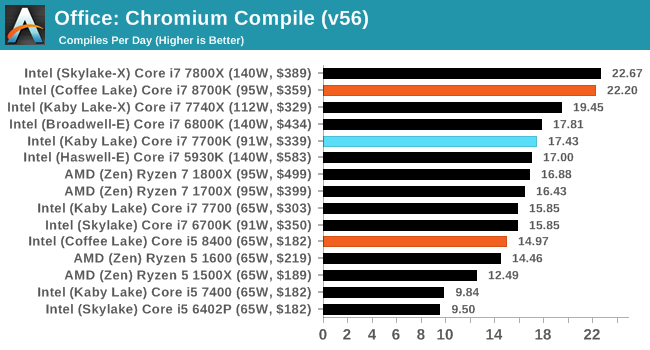
For our compile test, it would appear that the extra memory width afforded by the quad-channel memory of Skylake-X can have a direct benefit in compile performance.
PCMark 10
PCMark 10 is the 2017 update to the family favorite, PCMark 8. PCMark 8 has been part of our test bed since the latest update in Q1. For the most part it runs well, although for some processors it doesn’t recognize, some tests will not complete, leading to holes in our benchmark data (there’s also an odd directory quirk in one test that causes issues). The newest version, PCMark 10, is the answer.
The new test is adapted for more 2016/2017 workflows. With the advent of office applications that perform deeper compute tasks, or the wave of online gamers and streamers, the idea behind PCMark 10 is to give a better ‘single number’ result that can provide a comparable metric between systems. Single metrics never tell the whole story, so we’re glad that Futuremark provides a very detailed breakdown of what goes on.
Ganesh’s article on PCMark 10 goes into more detail than I will here, but the ‘Extended Benchmark’ runs through four different sets of tests: Essential, Productivity, Creation and Gaming. Each of these have sub-test results as well, including startup performance, web performance, video conferencing, photo/video editing, spreadsheets, rendering, and physics, which you can find in Bench.
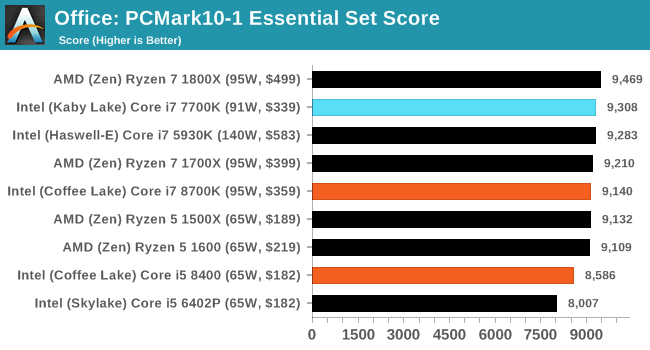

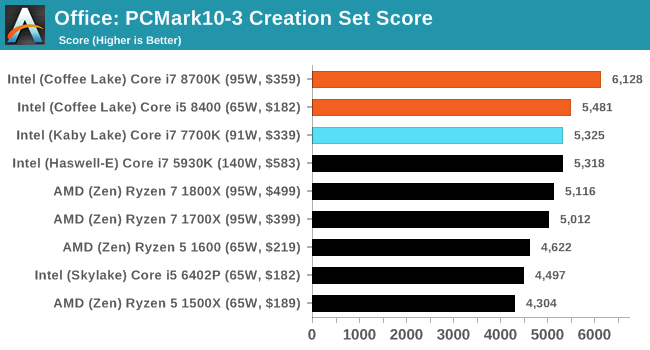
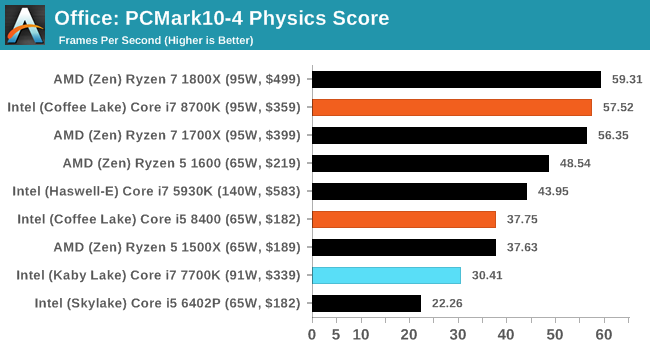
PCMark8: link
Despite originally coming out in 2008/2009, Futuremark has maintained PCMark8 to remain relevant in 2017. On the scale of complicated tasks, PCMark focuses more on the low-to-mid range of professional workloads, making it a good indicator for what people consider 'office' work. We run the benchmark from the commandline in 'conventional' mode, meaning C++ over OpenCL, to remove the graphics card from the equation and focus purely on the CPU. PCMark8 offers Home, Work and Creative workloads, with some software tests shared and others unique to each benchmark set.
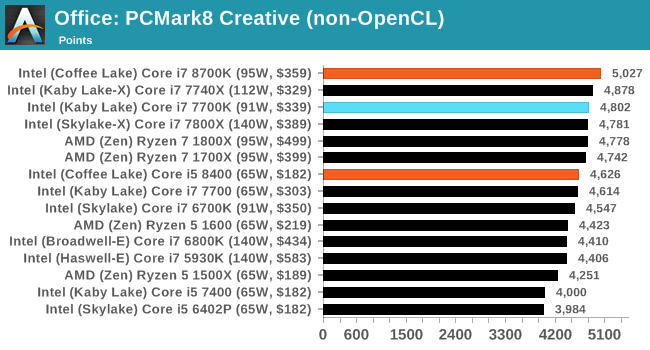
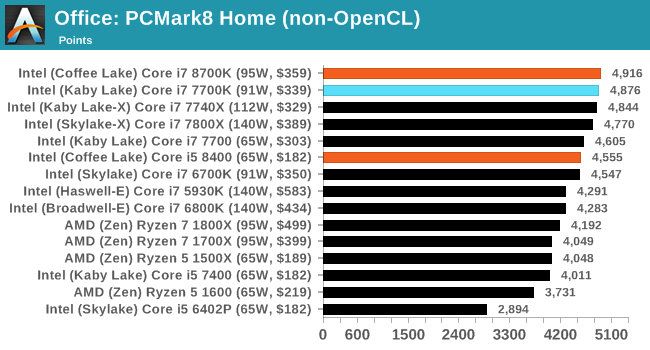
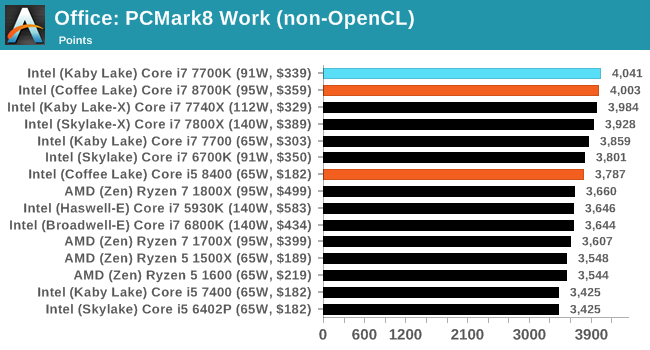










222 Comments
View All Comments
Chaser - Thursday, October 5, 2017 - link
Thank you AMD.vanilla_gorilla - Thursday, October 5, 2017 - link
Exactly! No matter what side you're on, you gotta love the fact that competition is back in the x86 desktop space! And it looks like AMD 1700X is now under $300 on Amazon. Works both ways!TEAMSWITCHER - Friday, October 6, 2017 - link
I just don't see it this way. Since the release of Haswell-E in 2014 we've had sub $400 six core processors. While some like to compartmentalize the industry into mainstream and HEDT, the fact is, I built a machine with similar performance three years ago, for a similar price. Today's full featured Z370 motherboards (like the ROG Maximus X) cost nearly as much as X99 motherboards from 2014. To say that Intel was pushed by AMD is simply not true.watzupken - Friday, October 6, 2017 - link
I feel the fact that Intel had to rush a 6 core mainstream processor out in the same year they introduced Kaby Lake is a sign that AMD is putting pressure on them. You may find a Haswell E chip for sub 400 bucks in 2014, but you need to be mindful that Intel historically have only increase prices due to the lack of competition. Now you are seeing a 6 core mainstream chip from both AMD and Intel below 200 bucks. Motherboard prices are difficult to compare since there are lots of motherboards out there that are over engineered and cost significantly more. Assuming you pick the cheapest Z370 motherboard out there, I don't believe it's more expensive than a X99 board.mapesdhs - Friday, October 6, 2017 - link
KL-X is dead, that's for sure. Some sites claim CFL was not rushed, in which case Intel knew KL-X would be pointless when it was launched. People claiming Intel was not affected by AMD have to choose: either CFL was rushed because of pressure from AMD, or Intel released a CPU for a mismatched platform they knew would be irrelevant within months.There's plenty of evidence Intel was in a hurry here, especially the way X299 was handled, and the horrible heat issues, etc. with SL-X.
mapesdhs - Friday, October 6, 2017 - link
PS. Is it just me or are we almost back to the days of the P4, where Intel tried to maintain a lead really by doing little more than raising clocks? It wasn't that long ago there was much fanfare when Intel released its first minimum-4GHz part (4790K IIRC), even though we all knew they could run their CPUs way quicker than that if need be (stock voltage oc'ing has been very productive for a long time). Now all of a sudden Intel is nearing 5GHz speeds, but it's kinda weird there's no accompanying fanfare given the reaction to their finally reaching 4GHz with the 4790K. At least in th mainstream, has Intel really just reverted to a MHz race to keep its performance up? Seems like it, but OS issues, etc. are preventing those higher bins from kicking in.KAlmquist - Friday, October 6, 2017 - link
Intel has been pushing up clock speeds, but (unlike the P4), not at the expense of IPC. The biggest thing that Intel has done to improve performance in this iteration is to increase the number of cores.mapesdhs - Tuesday, October 10, 2017 - link
Except in reality it's often not that much of a boost at all, and in some cases slower because of how the OS is affecting turbo levels.Remember, Intel could have released a CPU like this a very long time ago. As I keep having to remind people, the 3930K was an 8-core chip with two cores disabled. Back then, AMD couldn't even compete with SB, never mind SB-E, so Intel held back, and indeed X79 never saw a consumer 8-core part, even though the initial 3930K was a XEON-sourced crippled 8-core.
Same applies to the mainstream, we could have had 6 core models ages ago. All they've really done to counter the lack of IPC improvements is boost the clocks way up. We're approaching standard bin levels now that years ago were considered top-notch oc's unless one was definitely using giant air coolers, decent AIOs or better.
wr3zzz - Thursday, October 5, 2017 - link
I hope Anandtech solves the Civ6 AI benchmark soon. It's almost as important as compression and encoding benchmarks for me to decide CPU price-performance options as I am almost always GPU constrained in games.Ian Cutress - Saturday, October 7, 2017 - link
We finally got in contact with the Civ6 dev team to integrate the AI benchmark into our suite better. You should see it moving forward.